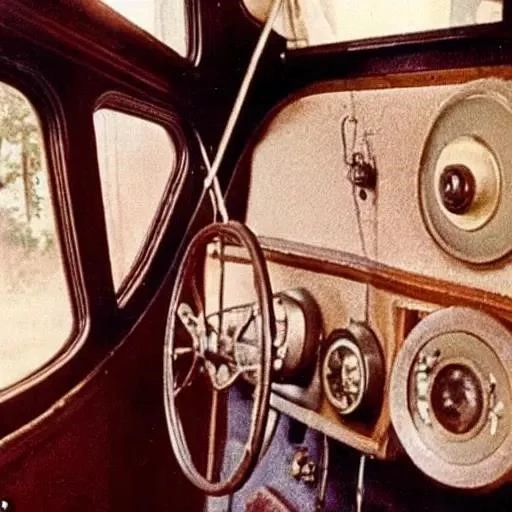
For decades, the automobile was a symphony of mechanical engagement, a driver’s journey intricately linked to the precise coordination of clutch and gear. Every acceleration, every deceleration, demanded a conscious, often strenuous, interaction with the vehicle’s powertrain. This ubiquitous dance, while familiar, presented a barrier to many, hinting at a future where driving could be simpler, more intuitive, and universally accessible. The automotive industry, ever a crucible of innovation, constantly sought to dismantle these mechanical hurdles, envisioning a world where the act of driving was less about shifting and more about experiencing the open road. This relentless pursuit of effortless motion eventually led to a breakthrough that would fundamentally redefine the driving experience for millions: the advent of the push-button transmission.
This ingenious leap wasn’t merely an incremental upgrade; it was a paradigm shift, a bold declaration that the future of automotive control lay not in levers and linkages, but in the elegant simplicity of a button press. It represented a profound re-imagining of how humans interacted with complex machinery, transforming a daunting task into a remarkably seamless operation. By integrating insights from burgeoning hydraulic technologies and a keen understanding of driver ergonomics, engineers embarked on a visionary quest to redefine automotive control, culminating in a system that felt both futuristic and profoundly intuitive. The convenience was undeniable, promising a driving experience freed from the tyranny of the gearstick, ushering in an era of unprecedented comfort and accessibility for the American motorist and beyond.
| Feature | Details |
|---|---|
| Pioneering Company | Chrysler Corporation |
| Key Innovation | PowerFlite Push-Button Control |
| 1956 (for widespread fully automatic push-button system) | |
| Models Featuring It | Initially on various Chrysler, DeSoto, Dodge, and Plymouth models (e.g., Chrysler New Yorker, Imperial) |
| Core Benefit | Simplified gear selection, enhanced driving convenience, freed up cabin space. |
| Technology Predecessors | Chrysler’s semi-automatic Fluid Drive (introduced 1939), Packard’s Ultramatic (1949), and various early automatic transmission developments. |
| Reference Link | Official Chrysler Website |
From Clunky Levers to Seamless Buttons: A Revolution on Wheels
The journey to push-button simplicity was paved with decades of experimentation. Prior to the mid-20th century, even the most sophisticated vehicles required drivers to master the intricate art of manual shifting. Early attempts at automatics, while functional, often retained cumbersome column or floor-mounted levers, still demanding a physical reach and pull. Chrysler, a company renowned for its engineering prowess, had already made strides with its semi-automatic Fluid Drive system in 1939, which, while not fully automatic, significantly reduced the need for constant gear changes. However, the true breakthrough, the moment that captivated the public imagination, arrived with the 1956 model year. Chrysler introduced its “PowerFlite” fully automatic transmission, ingeniously controlled by an array of dashboard-mounted push-buttons.
Suddenly, the bulky gear lever vanished, replaced by a sleek panel of buttons labeled ‘D’ for drive, ‘R’ for reverse, ‘N’ for neutral, and ‘L’ for low. This wasn’t just an aesthetic choice; it was a profound functional enhancement. Drivers, once wrestling with mechanical linkages, now merely pressed a button, and the car smoothly engaged the desired gear. This innovation was incredibly effective, liberating valuable cabin space and offering an unparalleled sense of modernity. Imagine the delight of a new owner, confidently pressing ‘D’ and gliding away, experiencing a level of driving ease previously unimaginable. The press hailed it as a marvel, and the public embraced it with open arms, recognizing the immense potential for comfort and convenience it represented in their daily commutes and cross-country adventures. It became a powerful symbol of progress, demonstrating how thoughtful design could elevate the driving experience.
The Enduring Legacy: Pushing Boundaries Beyond Buttons
While mechanical push-button transmissions eventually gave way to the more familiar PRNDL (Park, Reverse, Neutral, Drive, Low) lever-based automatics for a period, their initial impact was undeniable and their legacy persists; The idea of selecting gears with a simple, digital input laid the groundwork for future advancements. Today, we witness a resurgence of this concept, albeit in a far more sophisticated, electronic form. Modern vehicles often feature sleek rotary dials, elegant buttons, or even touch-sensitive pads to select drive modes, echoing the pioneering spirit of Chrysler’s 1956 innovation. This evolution underscores a continuous quest for intuitive control and minimalist design within the automotive cockpit, profoundly influencing everything from luxury sedans to electric vehicles.
Looking forward, the push-button transmission’s journey from a mechanical marvel to an electronic interface is a microcosm of the automotive industry’s trajectory towards an increasingly automated and digitally integrated future. As autonomous driving technologies advance, the very concept of “gear selection” might become obsolete, but the foundational principle of simplified human-machine interaction, championed by those early push-buttons, will undoubtedly endure. This innovative spirit, characterized by a relentless pursuit of convenience and an unwavering belief in technological progress, continues to drive the industry forward. From the satisfying click of a 1956 button to the seamless digital commands of tomorrow’s vehicles, the quest for a more intuitive and enjoyable driving experience remains an enduring testament to human ingenuity.
